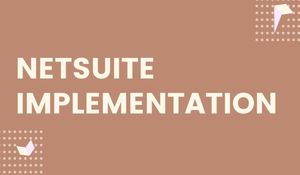
Key Steps for NetSuite Implementation
1. Requirement Definition and Business Process Review:
- Planning, Discovery, and Research – discuss the client’s goals and key challenges
- Business Requirements – conduct an onsite business review and complete a Business Requirements Documents (BRD), which baselines the project’s unique business needs
- Download Business Process Review Questionnaire
2. NetSuite Configuration:
- Basic setups – implement basic NetSuite functionality and add client-specific settings and content
- Customization – leverage native NetSuite features as well as create workflows and develop scripts
3. Data Migration:
- Import key data, such as customers and vendors in NetSuite
- Migrate historical data from a legacy system that is the custom solutions
- Download NetSuite Data Migration Plan

4. Testing/UAT:
- User Acceptance Testing (UAT) Documentation – develop customized User Acceptance Testing’s for key NetSuite business processes
- Quality Assurance Testing – Organizations and their clients participate in rigorous testing of NetSuite before deployment to ensure readiness
5. Client Training:
- Train clients on the use of NetSuite to ensure that their team is prepared to use the new functionality
- View specific NetSuite training services
Who will do your NetSuite implementation?
Self-implementation
Implementing NetSuite on your own is an alternative, but not one that we would suggest. Unless we have a dedicated in-house resource with extensive NetSuite experience. There are many challenges with self-implementation, but in most cases, small to mid-size companies do not have the resources, time, or expertise to implement ERP successfully on their own.
Direct Implementation
If you choose to buy the software directly through NetSuite, their team will likely handle your implementation project. In certain cases, they may pull in a partner of their choosing to do the implementation for you. Given that they’re the software publisher, you won’t run into issues around product knowledge and technical expertise. But implementing ERP software is about far more than just software. You want your implementation team to have a strong understanding of your business, not just businesses like yours. The NetSuite direct team tends to take a more prescriptive approach, so you won’t get the same depth that you will with a NetSuite implementation partner.
Partner Implementation
When you work with a NetSuite partner, you are building a strong relationship to support your business in the long-term. Your partner becomes an extension of your team, as they go indepth to understand every facet of your business to create a solution that truly fits your business. And NetSuite partners have comparable levels of technical expertise, giving them a distinct advantage over the direct model. Remember, this is the core system that runs your business. Having a partner that’s invested in your success is essential. You’ll want to select your ERP partner as carefully as you select the software itself to ensure a good fit.
Best implementation method for your project
Based on requirements there are two approaches to choose:
- Traditional ERP implementation approach
- NetSuite’s SuiteSuccess model
Traditional ERP Implementation
Following are steps with details on a traditional ERP implementation plan:
- Process analysis and design: This stage starts before you even buy the software. The information collected during discovery is used as a basis for a deeper dive into your processes and requirements. It is worth the effort up-front, rather than spending money on modifications later.
- Software configuration: The collaborator handles the initial setup of your system.
- Data migration: Dedicate time for your team to clean your existing data before importing it into your NetSuite system.
- Business process implementation: Configuring the system to handle the business processes you mapped out in the design phase.
- Training and user acceptance testing: Core users will start learning using the system with a combination of NetSuite materials and collaborative training. To know how to perform processes it is a great idea for users to have basic training before they start testing.
- System go-live: Start to use the NetSuite system.
- Post-implementation review and support: Continue working closely on training and process optimization before moving into support mode.
SuiteSuccess Implementation
The SuiteSuccess implementation approach is a great starting point for small, simple companies. Rather than starting your project from a blank slate, the implementation is standardized to solve the challenges in your industry using best practices. You get a faster time to value with pre-defined workflows, KPIs, dashboards, and more, implemented in a phased approach. But keep in mind that this approach is more prescriptive, so you’ll have to fit your business processes to the software which can be limiting.
- Build: A complete suite to support your business including ERP, CRM, PSA, omnichannel commerce, HR, and Business Intelligence (BI) built on the NetSuite cloud platform.
- Engage Leverage best practices for each industry and role including workflows, KPI reports, dashboards, and metrics.
- Consume: A carefully crafted staged approach allows you to consume capabilities based on your business needs and get you running in the cloud in 100 days.
- Optimize: You’re always on the latest release, giving you the benefit of updated leading practices, new features, and ongoing process improvement. Identify any gaps in the SuiteSuccess template up-front and provide an estimate and project plan to implement any additional functionality required to meet your business needs.

Tips for a successful NetSuite implementation
- Well, we cannot draw attention enough to the importance of your relationship with your implementation partner. They will ensure your system meets up with your needs and guide you through the process. There are a few things to ensure your successful implementation. To manage the selection and implementation internally create a cross-functional project team. They will collect feedback from other users throughout the process to ensure you have a crystal clear idea.
- It is a big change where people will be learning both new systems and new processes.
- Implementing a new system is disruptive and the transition can be hard on your team. Do not overlook the importance of change management. A proper change management strategy will ease the stress and improve user adoption.
- Document your new processes. It is worth it yet it takes time. This becomes the training manual for your team and ensures new processes are being followed.
- Use the NetSuite Sandbox. it gives your users the opportunity to learn the system in a safe environment, without impacting production data.
Author Bio

Kavya Sathvik, A content strategist at Gologica. She has 2 years of experience in content writing. Passionate about writing technical content and also creating effective content strategy for brands and blogs. Contact her: Linkedin











